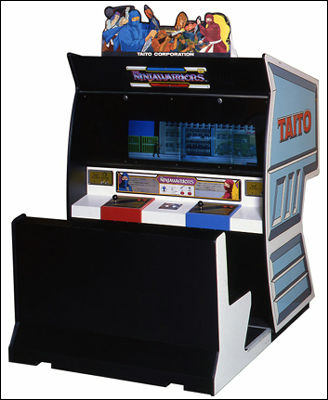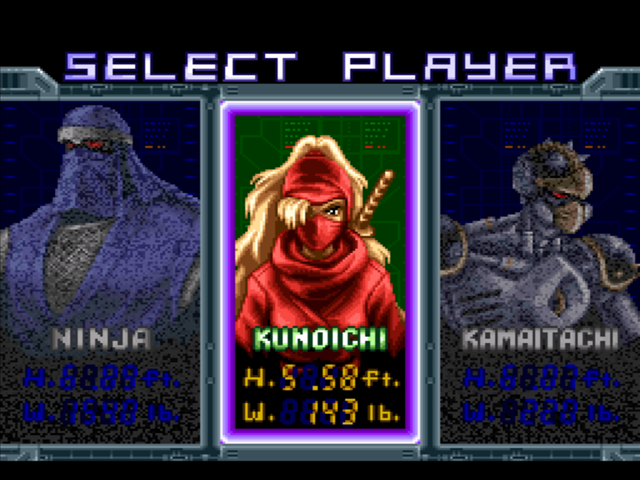I remember walking into an Arcade and seeing this massive 3-screen spectacle full of jumping ninjas and army guys. It was probably the single most impressive game in the place at first glance. The Ninja Warriors was an immediate draw and drained two-quarters right out of my pocket. The animation was fluid and smooth, battle damage was brilliantly indicated as pieces of your character's clothes ripped off, the music was a pumping synth-rock and the entire experience was top-notch at first glance. The problem was that there really wasn't much of a game there once you dug in beyond the initial surface. You walked to the right and used your two or three moves against an endless army of nameless mooks. After about 15 minutes I was bored to tears.
Taito used a similar 3-screen setup for its Darius games. In fact, instead of just putting three screens side-by-side and dealing with the bezels, the first and third screens sat down in the cabinet and pointed up at mirrors that surrounded the middle, forward facing, monitor. The gave a nearly seamless extra widescreen that was impossible with any other technology of the time and like movie magic that's all smoke and mirrors was an unmistakable attention grabbing special effect in the arcade that's still not matched in the home experience today.
Still this game proved popular enough to receive quite a few home ports (minus two of the screens) to most of the major systems of the time. The TurboGrafx-16/PCEngine and the SegaCD/MegaCD ports were probably the best. However, the basic gameplay remained sadly unchanged and the game more or less fell out of memory.
So when Taito decide to release Ninja Warriors for the SNES/Super Famicom I think it was assumed it would be yet another direct port. Instead Taito decided to give the job to Natsume and gave them more or less free reign to properly adapt the game to the home market.
Natsume kept the signature female robot ninja, the army of nameless mooks, the great graphics and animation and the title and then pretty much tossed the rest. What came out of the complete redesign processes is probably one of the most polished games of the 16-bit generation.
The arcade also had a second player male ninja, which in this version was amped up into a huge mechanized nunchuck whipping monstrosity and then added a third robot with bladed forearms to literally tear through the enemy. Taking this group of robot killers, the game then blessed them each with an surprisingly large move list. So large that I'm still finding new moves and ways to use the characters years later. The character play kind of like a cross between a full-on fighting game like Street Fighter II and Final Fight but is unique enough to feel completely like its own game.
Gameplay here is king.
There's other differences as well. This is one of those rare beat-em-ups that's not set in a simulated 3d space (often called a belt-scroll). You'd think that the lack of the extra dimension would limit the gameplay options, but somehow it still works and I think keeps the game moving at a faster pace. Instead of walking around groups of enemies for better position, or exploiting bugs in the hit boxes, you have to jump around or throw individual enemies to group them.
There's also loads of tossable items, motorbikes, computer consoles, crates full of lifebar energy and more. The environments are also full of destructible background bits, energy conduits, vats and other sundry -- toss an enemy through the air and his lifeless corpse takes out some valuable equipment and six of his closest friends. It's unbelievably fun.
There's also loads of enemies that all use different attack strategies. Even the palette swap enemies act differently. Some hang back, then come in for a low attack, others run in direct, others are tall armored robots. There's even entire groups of martial arts experts and long range snipers. Bosses are similarly varied and creative. From a light bending predator like to a cane wielding bond villain who can call on an orbiting ion cannon. On top of this, the levels toss all manner of cinematic special effects at you. In a few places you have to dodge mortars, helicopters firing a side-mounted vulcan and more. This game keeps tossing more and more at you and never gets boring.
Sound effects are pretty standard Super Famicom stuff: they're fine, don't get in the way, and get the job done - but nothing really to write home about. Music is the same, nothing fancy, but fades into the background and keeps things moving. You won't find lots of covers on youtube for the otherwise forgettable tunes.
I really want to pound in the point how polished this game is. The tiniest details were clearly sweated over, from menu graphics on. There's nothing that really stands out and makes you think that this a B grade effort. Natsume went all out. And it's this detail that let's you kick back, relax and bring robotic murder to hundreds of enemies for about an hour. How it doesn't make more top-10 or top-20 lists is beyond me.













































.jpg)


